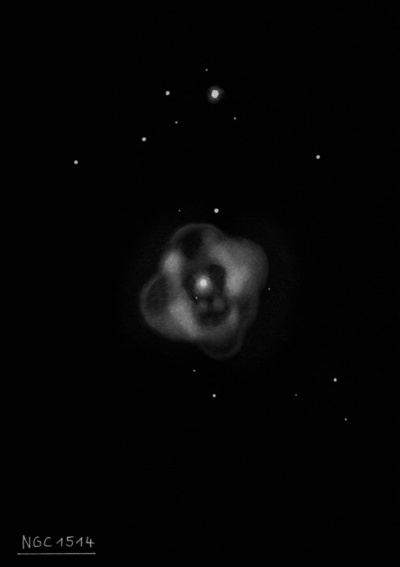
William Herschel discovered NGC 1514 = H IV-69 = h311 on 13 Nov 1790 (sweep 980) and wrote, "A most singular phenomenon. A star of about 8th magnitude with a faint luminous atmosphere of a circular form, and about 3' in diameter. The star is perfectly in the center and the atmosphere is so diluted, faint and equal throughout that there can be no surmise of its consisting of stars; nor can there be a doubt of the evident connection between the atmosphere and the star. Another star, not much less in brightness and in the same field with the above, was perfectly free from any such appearance."
The striking symmetry of NGC 1514 caused Herschel to rethink his idea of planetary nebulae. He previously assumed all nebulae were unresolved stellar clusters of some kind, disguised by their great distance. After this point, he was convinced of the existence of pure nebulosity, out of which individual stars or planets were born and he no longer expected every nebula to be resolved with enough aperture. This essentially destroyed his interest in the 40-foot telescope (48-inch aperture), although the difficulty in using this unwieldy scope was also a major factor.
A total of 20 observations were made with the 72" at Birr Castle with one of the earliest (13 Jan 1852) by Bindon Stoney. He described NGC 1514 as a "new spiral of an annular form round the star, which is central; Brightest part is sf the star, spirality is very faint, but I have no doubt of its existence". Stoney and later R.J. Mitchell sketched an irregular rim with brighter and dimmer sections. Samuel Hunter made a sketch on 9 Jan 1858 with a brighter reversed "S" shape within an oval halo. A version of this sketch was chosen (over Stoney and Mitchell's sketches) for LdR's 1861 publication (plate XXV, figure 7). Resolving spiral structure was a major theme at Birr Castle but irregularities in the rim was likely the cause of this illusion.
300/350mm - 13.1" (12/22/84): bright, fairly large, round, dominated by a mag 9.5 central star.
400/500mm - 17.5" (12/30/99): at 100x, moderately bright, round, ~2' halo surrounding a prominent mag 9.5 star. Displayed an excellent response to UHC and OIII blinking while the H-beta filter killed the PN (OIII/H-beta = 12). Using the OIII filter, the surface brightness was noticeably uneven, with the NW quadrant of the rim clearly brighter. The SE end was also weakly enhanced while the center and ends of the minor axis were slightly darker. At 220x using a UHC filter, the halo appeared nearly 2.5' in diameter. There was a small, darker "hole" surrounding the central star and the halo was clearly irregular with a brighter "knot" on the SE side, while the NW portion of the halo was brighter along the rim.
17.5" (9/14/85): very bright, large, round, 2' diameter. Contains a very bright mag 9.5 central star surrounded by a fairly bright halo with an irregular surface brightness. Located midway between mag 8.3 SAO 57017 8' NNW and mag 9 SAO 57021 8' S.
900/1200mm - 48" (10/25/14): at 610x unfiltered; very bright and large; very irregular surface brightness, the rim varies greatly in thickness and brightness. The relatively thick rim is very bright in the northwest quadrant, along roughly a 70? arc. A second enhanced portion of the rim is along the southeast end (~35? arc) and a third slightly smaller, bright region (more circular) is on the east end. The rim is weak on the south or south-southwest end as well as the north and northeast side. A mag 17 star is at the edge of the rim on the southwest end. A few modest outer lobes were evident; the rim bulges out on the southeast side (near the two enhancements on this end) and to a lesser extent on the northwest and the south end. The mag 9.5 star at the center and a very faint companion to its southeast are surrounded by a darker central hole.
Notes by Steve Gottlieb